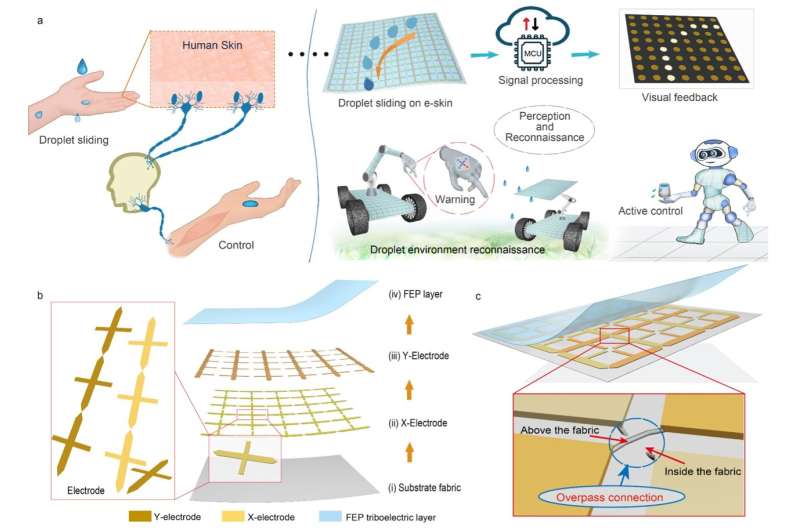August 6, 2024 feature
This article has been reviewed according to Science X's editorial process and policies. Editors have highlighted the following attributes while ensuring the content's credibility:
fact-checked
peer-reviewed publication
trusted source
proofread
A droplet-sensing bionic e-skin that could further enhance robotic perception

In recent years, many research teams have been trying to design artificial skins with electronic properties for humanoid robots, smart prosthetics and other bio-inspired systems. These skins could sense the textures and tactile properties of objects, allowing various systems to plan their actions based on the information they detected.
Researchers at Donghua University and the National University of Singapore recently developed a new electronic skin (e-skin) that can also perceive information related to the sliding of liquids on objects. This e-skin, presented in a paper published in Nature Communications, can convert dynamic droplet sliding behaviors into electrical signals, which are then fed to an indicator.
"Our droplet e-skin (DES) is designed to enhance the ability of intelligent robots to sense droplet environments, reducing the gap between robotic e-skin and human skin in droplet perception," Yunlong Xu, first author of the paper, told Tech Xplore. "This is because there is currently no e-skin that deeply perceives the sliding behavior of liquid droplets."
Humans are innately capable of detecting the sliding behavior of liquid droplets on their skin, which can prove valuable when completing manual tasks in wet environments. To reproduce this capability in their e-skin, Bai and his colleagues drew inspiration from an everyday phenomenon, namely that of a soccer ball rolling on a floor tile.
"This work was mainly carried out by the team from Donghua University, with the experimental optimization and paper revision by Chengkuo Lee and Zhongda Sun from the National University of Singapore, as well as help from Zhiqing Bai with revising the paper," Xu said. "Our e-skin is based on a triboelectric mechanism, i.e., contact electrification and electrostatic induction between the droplet and the e-skin."
The DES created by this team of researchers is comprised of an interlaced network of electrodes. These electrodes can detect various dynamic sliding behaviors of droplets, using the friction they produce to convert them into electrical signals.
"The perception of the sliding behavior of the droplet is mainly attributed to the design of an ingenious network of co-layered interlaced electrodes," Xu explains. "These are comprised of two series of electrodes on the same layer that don't conduct to each other. Our design also ensures that the induction distance between the droplet and each series of electrodes is the same."
After the e-skin has converted the behavior of sliding droplets into electrical signals, it sends a visual feed of these behaviors to an indicator. Notably, the skin can also monitor the direction in which droplets are flowing and control the leakage of water.
"This paper provides a self-powered bionic droplet electronic skin to deeply perceive the droplet sliding behaviors by converting various dynamic droplet sliding behaviors into electrical signals, thereby empowering intelligent robotic devices with augmented perception in common droplet environments," Xu said.
The e-skin introduced in this recent paper could soon be integrated in real-world robotic systems to further assess its performance. In the future, it could contribute to the development of humanoid robots with more advanced tactile sensing capabilities, further bridging the gap between human and robot sensory perception.
"Our bionic DES greatly narrows the gap between artificial e-skin and human skin in perception ability, and bring promising applications in military, rescue, and daily life," Xu added. "We now plan to continue to optimize its sensitivity and anti-interference capabilities, and to use machine learning to enable its more powerful perception capabilities."
More information: Yunlong Xu et al, Bionic e-skin with precise multi-directional droplet sliding sensing for enhanced robotic perception, Nature Communications (2024). DOI: 10.1038/s41467-024-50270-8
© 2024 Science X Network




















